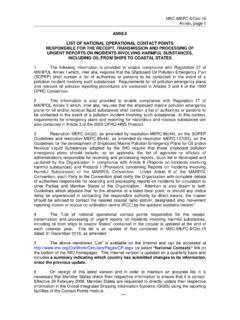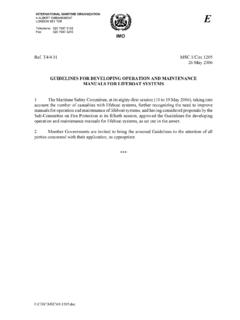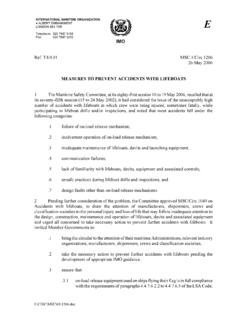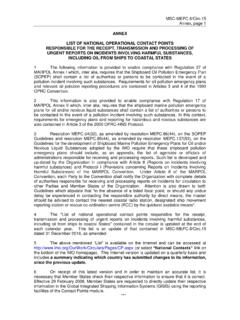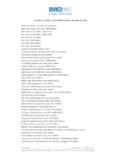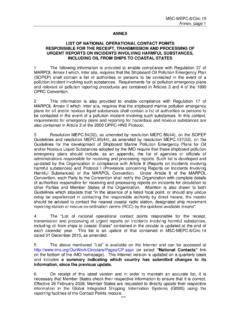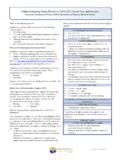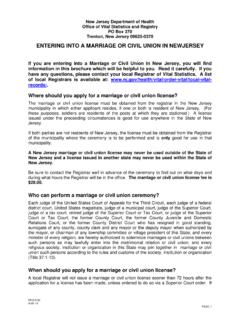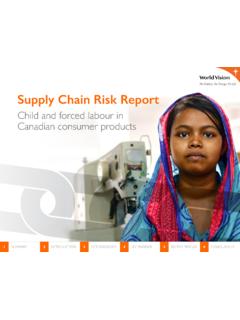Transcription of Resolution A.1050(27) (Agenda item 9) REVISED ...
1 I:\ASSEMBLY\27\RES\ E ASSEMBLY 27th session Agenda item 9 A 27 December 2011 Original: ENGLISH Resolution (27) Adopted on 30 November 2011 (Agenda item 9) REVISED RECOMMENDATIONS FOR entering ENCLOSED SPACES ABOARD SHIPS THE ASSEMBLY, RECALLING Article 15(j) of the Convention on the International Maritime Organization regarding the functions of the Assembly in relation to regulations and guidelines concerning maritime safety, RECALLING ALSO its adoption, by Resolution (20), of the Recommendations for entering enclosed spaces aboard ships, incorporating therein recommendations for entering cargo spaces, tanks, pump-rooms, fuel tanks, cofferdams, duct keels, ballast tanks and similar enclosed spaces, BEING CONCERNED about the continued loss of life resulting from personnel entering shipboard spaces in which the atmosphere is oxygen-depleted, oxygen-enriched, toxic or flammable, BEING AWARE of the work undertaken in this regard by the International Labour Organization, Governments and segments of the private sector, HAVING CONSIDERED the recommendation made by the Maritime Safety Committee at its eighty-ninth session, 1.
2 ADOPTS the REVISED Recommendations for entering enclosed spaces aboard ships, as set out in the Annex to the present Resolution ; 2. INVITES Governments to bring the annexed REVISED recommendations to the attention of shipowners, ship operators and seafarers, urging them to apply them, as appropriate, to all ships; 3. REQUESTS the Maritime Safety Committee to keep the REVISED recommendations under review and amend them as necessary; 4. REVOKES Resolution (20). A 27 Page 2 I:\ASSEMBLY\27\RES\ Annex REVISED RECOMMENDATIONS FOR entering ENCLOSED SPACES ABOARD SHIPS PREAMBLE The objective of these recommendations is to encourage the adoption of safety procedures aimed at preventing casualties to ships' personnel entering enclosed spaces where there may be an oxygen-deficient, oxygen-enriched, flammable and/or toxic atmosphere.
3 Investigations into the circumstances of casualties that have occurred have shown that accidents on board ships are in most cases caused by an insufficient knowledge of, or disregard for, the need to take precautions rather than a lack of guidance. The following practical recommendations apply to all types of ships and provide guidance to ship operators and seafarers. It should be noted that on ships where entry into enclosed spaces may be infrequent, for example, on certain passenger ships or small general cargo ships, the dangers may be less apparent, and accordingly there may be a need for increased vigilance. The recommendations are intended to complement national laws or regulations, accepted standards or particular procedures which may exist for specific trades, ships or types of shipping operations.
4 It may be impracticable to apply some recommendations to particular situations. In such cases, every endeavour should be made to observe the intent of the recommendations, and attention should be paid to the risks that may be involved. 1 INTRODUCTION The atmosphere in any enclosed space may be oxygen-deficient or oxygen-enriched and/or contain flammable and/or toxic gases or vapours. Such unsafe atmospheres could also subsequently occur in a space previously found to be safe. Unsafe atmospheres may also be present in spaces adjacent to those spaces where a hazard is known to be present. 2 DEFINITIONS Enclosed space means a space which has any of the following characteristics: .1 limited openings for entry and exit; .2 inadequate ventilation; and.
5 3 is not designed for continuous worker occupancy, and includes, but is not limited to, cargo spaces, double bottoms, fuel tanks, ballast tanks, cargo pump-rooms, cargo compressor rooms, cofferdams, chain lockers, void spaces, duct keels, inter-barrier spaces, boilers, engine crankcases, engine scavenge air receivers, sewage tanks, and adjacent connected spaces. This list is not exhaustive and a list should be produced on a ship-by-ship basis to identify enclosed spaces. A 27 Page 3 I:\ASSEMBLY\27\RES\ Adjacent connected space means a normally unventilated space which is not used for cargo but which may share the same atmospheric characteristics with the enclosed space such as, but not limited to, a cargo space accessway. Competent person means a person with sufficient theoretical knowledge and practical experience to make an informed assessment of the likelihood of a dangerous atmosphere being present or subsequently arising in the space.
6 Responsible person means a person authorized to permit entry into an enclosed space and having sufficient knowledge of the procedures to be established and complied with on board, in order to ensure that the space is safe for entry. Attendant means a person who is suitably trained within the safety management system, maintains a watch over those entering the enclosed space, maintains communications with those inside the space and initiates the emergency procedures in the event of an incident occurring. 3 SAFETY MANAGEMENT FOR ENTRY INTO ENCLOSED SPACES The safety strategy to be adopted in order to prevent accidents on entry to enclosed spaces should be approached in a comprehensive manner by the company. The company should ensure that the procedures for entering enclosed spaces are included among the key shipboard operations concerning the safety of the personnel and the ship, in accordance with paragraph 7 of the International Safety Management (ISM) Code.
7 The company should elaborate a procedural implementation scheme which provides for training in the use of atmospheric testing equipment in such spaces and a schedule of regular onboard drills for crews. Competent and responsible persons should be trained in enclosed space hazard recognition, evaluation, measurement, control and elimination, using standards acceptable to the Administration. Crew members should be trained, as appropriate, in enclosed space safety, including familiarization with onboard procedures for recognizing, evaluating and controlling hazards associated with entry into enclosed spaces. Internal audits by the company and external audits by the Administration of the ship's safety management system should verify that the established procedures are complied with in practice and are consistent with the safety strategy referred to in paragraph 4 ASSESSMENT OF RISK The company should ensure that a risk assessment is conducted to identify all enclosed spaces on board the ship.
8 This risk assessment should be periodically revisited to ensure its continued validity. In order to ensure safety, a competent person should always make a preliminary assessment of any potential hazards in the space to be entered, taking into account previous cargo carried, ventilation of the space, coating of the space and other relevant factors. The competent person's preliminary assessment should determine the potential for the presence of an oxygen-deficient, oxygen-enriched, flammable or toxic atmosphere. The competent person should bear in mind that the ventilation procedures for an adjacent A 27 Page 4 I:\ASSEMBLY\27\RES\ connected space may be different from the procedures for the ventilation of the enclosed space itself.
9 The procedures to be followed for testing the atmosphere in the space and for entry should be decided on the basis of the preliminary assessment. These will depend on whether the preliminary assessment shows that: .1 there is minimal risk to the health or life of personnel entering the space; or .2 there is no immediate risk to health or life but a risk could arise during the course of work in the space; or .3 a risk to health or life is identified. Where the preliminary assessment indicates minimal risk to health or life or potential for a risk to arise during the course of work in the space, the precautions described in sections 5, 6, 7 and 8 should be followed, as appropriate. Where the preliminary assessment identifies a risk to life or health, if entry is to be made, the additional precautions specified in section 9 should also be followed.
10 Throughout the assessment process, there should be an assumption that the space to be entered is considered to be hazardous until positively proved to be safe for entry. 5 AUTHORIZATION OF ENTRY No person should open or enter an enclosed space unless authorized by the master or the nominated responsible person and unless the appropriate safety procedures laid down for the particular ship have been followed. Entry into enclosed spaces should be planned and the use of an entry permit system, which may include the use of a checklist, is recommended. An Enclosed Space Entry Permit should be issued by the master or the nominated responsible person, and completed by the personnel who enter the space prior to entry. An example of the Enclosed Space Entry Permit is provided in the appendix.
